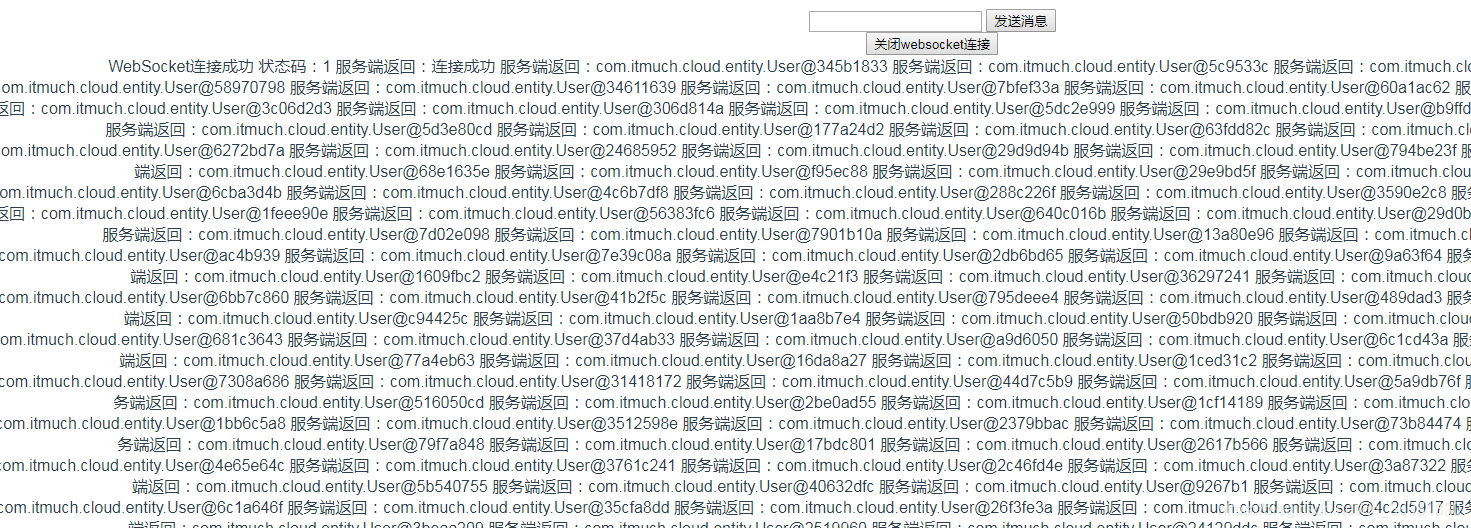最近公司有需求集成websocket,前端使用vue,后端采用springboot,废话不多说,开鲁代码:
vue:
<template>
<div>
<input type="text" v-model="text">
<button @click="send()">发送消息</button>
<br>
<button @click="closeWebSocket()">关闭websocket连接</button>
<br>
<div>{{data}}</div>
</div>
</template>
<script>
export default {
name: 'Login',
data() {
return {
text: '',
data: '',
websocket: null
}
},
mounted() {
if ('WebSocket' in window) {
this.websocket = new WebSocket('ws://localhost:7900/websocket')
this.initWebSocket()
} else {
alert('当前浏览器 Not support websocket')
}
},
beforeDestroy() {
this.onbeforeunload()
},
methods: {
initWebSocket() {
//连接错误
this.websocket.onerror = this.setErrorMessage
// //连接成功
this.websocket.onopen = this.setOnopenMessage
//收到消息的回调
this.websocket.onmessage = this.setOnmessageMessage
//连接关闭的回调
this.websocket.onclose = this.setOncloseMessage
//监听窗口关闭事件,当窗口关闭时,主动去关闭websocket连接,防止连接还没断开就关闭窗口,server端会抛异常。
window.onbeforeunload = this.onbeforeunload
},
setErrorMessage() {
this.data = "WebSocket连接发生错误" + ' 状态码:' + this.websocket.readyState;
},
setOnopenMessage() {
this.data = "WebSocket连接成功" + ' 状态码:' + this.websocket.readyState;
},
setOnmessageMessage(event) {
this.data += "\n\r" + '服务端返回:' + event.data;
},
setOncloseMessage() {
this.data = "WebSocket连接关闭" + ' 状态码:' + this.websocket.readyState;
},
onbeforeunload() {
this.closeWebSocket();
},
//websocket发送消息
send() {
this.websocket.send(this.text)
this.text = ''
},
closeWebSocket() {
this.websocket.close()
}
}
}
</script>
后端 springboot:
Maven依赖:
<!-- websocket --> <dependency> <groupId>org.springframework.boot</groupId> <artifactId>spring-boot-starter-websocket</artifactId> </dependency>
WebSocket的配置
WebSocketConfig:
package com.itmuch.cloud.config;
import org.springframework.context.annotation.Bean;
import org.springframework.context.annotation.Configuration;
import org.springframework.web.socket.server.standard.ServerEndpointExporter;
@Configuration
public class WebSocketConfig {
@Bean
public ServerEndpointExporter serverEndpointExporter(){
return new ServerEndpointExporter();
}
}
WebSocketServer.class
WebSocketServer相当于ws协议的Controller,直接@ServerEndpoint("/websocket")@Component启用即可,代码如下:
package com.itmuch.cloud.controller;
import org.springframework.stereotype.Component;
import javax.websocket.*;
import javax.websocket.server.ServerEndpoint;
import java.io.IOException;
import java.util.concurrent.CopyOnWriteArraySet;
/**
* websocket工具
*/
@Component
@ServerEndpoint("/websocket")
public class WebSocketServer {
//静态变量,用来记录当前在线连接数。应该把它设计成线程安全的
private static int onlineCount = 0;
//concurrent包的线程安全Set,用来存放每个客户端对应的MyWebSocket对象
private static CopyOnWriteArraySet<WebSocketServer> webSocketSet = new CopyOnWriteArraySet<WebSocketServer>();
//与某个客户端的连接会话,需要通过它给客户端发送数据
private Session session;
/**
* 连接建立成功调用的方法
*/
@OnOpen
public void onOpen(Session session){
this.session = session;
webSocketSet.add(this); //加入到set中
addOnlineCount(); //在线数加1
System.out.println("当前在线人数为" + getOnlineCount());
try{
sendMessage("连接成功");
}catch(IOException e){
System.out.println("websocket有异常");
}
}
/**
* 连接关闭调用的方法
*/
@OnClose
public void onClose(){
webSocketSet.remove(this); //从set中删除
subOnlineCount();
System.out.println("有一连接关闭!当前在线人数为" + getOnlineCount());
}
/**
* 收到客户端信息后调用的方法
* @param message 客户端发送过来的消息
*/
@OnMessage
public void onMessage(String message,Session session){
System.out.println("客户端的信息:"+message);
//群发消息
for(WebSocketServer item : webSocketSet){
try {
item.sendMessage(message);
} catch (Exception e) {
e.printStackTrace();
}
}
}
/**
* 发生错误时调用
* @param session
* @param error
*/
@OnError
public void onError(Session session,Throwable error){
System.out.println("发送错误");
error.printStackTrace();
}
/**
* 服务器的主动推送
*/
public void sendMessage(String message) throws IOException{
this.session.getBasicRemote().sendText(message);
}
/**
* 群发自定义消息
*/
public static void sendInfo(String message) throws IOException{
for(WebSocketServer item : webSocketSet){
try {
item.sendMessage(message);
} catch (Exception e) {
continue;
}
}
}
public static synchronized int getOnlineCount(){
return onlineCount;
}
public static synchronized void addOnlineCount(){
WebSocketServer.onlineCount++;
}
public static synchronized void subOnlineCount(){
WebSocketServer.onlineCount--;
}
}
写一个bean,用来测试:
package com.itmuch.cloud.entity;
import java.math.BigDecimal;
import javax.persistence.Column;
import javax.persistence.Entity;
import javax.persistence.GeneratedValue;
import javax.persistence.GenerationType;
import javax.persistence.Id;
@Entity
public class User {
public User(Long id, String username) {
super();
this.id = id;
this.username = username;
}
public User() {
super();
}
@Id
@GeneratedValue(strategy = GenerationType.AUTO)
private Long id;
@Column
private String username;
@Column
private String name;
@Column
private Short age;
@Column
private BigDecimal balance;
public Long getId() {
return this.id;
}
public void setId(Long id) {
this.id = id;
}
public String getUsername() {
return this.username;
}
public void setUsername(String username) {
this.username = username;
}
public String getName() {
return this.name;
}
public void setName(String name) {
this.name = name;
}
public Short getAge() {
return this.age;
}
public void setAge(Short age) {
this.age = age;
}
public BigDecimal getBalance() {
return this.balance;
}
public void setBalance(BigDecimal balance) {
this.balance = balance;
}
}
最后写一个Controller,想法是这样的,访问Controller的方法的时候,后端向前端推送数据,Controller代码如下:
package com.itmuch.cloud.controller;
import com.itmuch.cloud.entity.User;
import org.springframework.web.bind.annotation.RequestMapping;
import org.springframework.web.bind.annotation.RestController;
@RestController
@RequestMapping("/socketcenter")
public class WebsocketController {
/**
* 推送消息
* @param message
*/
@RequestMapping("socket/push")
public void pushToWeb(String message){
try {
for(int i = 0; i <= 1000; i++){
User user = new User();
long k = i;
user.setId(k);
user.setName(i+"_zhang");
WebSocketServer.sendInfo(user.toString());
}
} catch (Exception e) {
e.printStackTrace();
}
}
}
访问 http://localhost:7900/socketcenter/socket/push?message=aaa
可以看到前端推送的代码:





 本文详细介绍如何在Vue前端和SpringBoot后端之间实现WebSocket通信。前端利用Vue框架结合WebSocket进行实时消息收发,后端则通过SpringBoot的WebSocket支持进行消息处理与推送。文章覆盖了代码实现、依赖配置及测试方法。
本文详细介绍如何在Vue前端和SpringBoot后端之间实现WebSocket通信。前端利用Vue框架结合WebSocket进行实时消息收发,后端则通过SpringBoot的WebSocket支持进行消息处理与推送。文章覆盖了代码实现、依赖配置及测试方法。
















 894
894

 被折叠的 条评论
为什么被折叠?
被折叠的 条评论
为什么被折叠?








